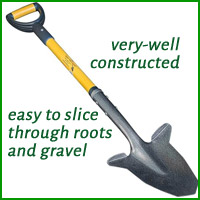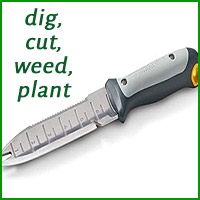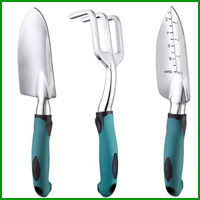New England Gardening Advice By the Month -May
Last Updated:
By now, even the staunchest naysayer has to admit that Spring has arrived. The grass is about as green as it will be throughout the season, the crocus have come and gone and the daffodils are making an appearance from south to north on the heels of warmer and longer days.
If you followed our advice last month, you took an hour or two to clean out the planting beds to allow the spring flowering bulbs a chance to show their faces. Now is the time to examine these and all other locations and focus on what to do when the spring flowers die back in the next month or so. You have a great opportunity here, to plant either annuals or perennials in and around the daffodils and crocus so you have a non-stop display of color throughout the season.
While your spring bulbs are still alive, mark off the spots around them for summer plantings
If you forget to do this step, you will probably forget exactly where the early spring flowering bulbs are located in the garden. This makes adding your perennials and annuals much more difficult because you could potentially place these plants on top of the spring bulbs. Not good garden planning. If you plan your garden now, you'll know exactly where the spring bulbs are so you can plant amongst the bulbs without disturbing them.
Choose hardy plants if you want some mid-spring color in the garden
The pansy and the viola are great choices for May planting. Even in May, the unpredictable New England weather produces bursts of 80+ degree days and sometimes 25 degree nights. On occasion, even a snow flurry drops a healthy coating of snow on spring gardens. Dont' worry... these plants can take the cold and heat extremes better than most plants. It will tend to die back in the heat of the summer but often comes back full force in the fall, usually from the spring plants producing seed which lie dormant during the hot summer months. Add all this to the fact that they are available at virtually any garden center and you've got a real winner for your spring garden in May and June.
Get your indoor plants ready for the big move outdoors for the summer
May is also the time you want to start conditioning your plants that have been indoors all winter to the outdoors if you plan on putting them on a patio (or your vegetables that you started from seed inside). "Hardening off" your plants like this does two things: first, it helps them develop stronger stems that they will need to stay upright during outdoor windy conditions. Secondly, it allows your plants to acclimate to the strong outdoor sun slowly. This is done by exposing your plants during short periods of time to the outdoors and then bringing them inside again, 1 or 2 hours at a time. If you were to put indoor plants outside full-time without this adjustment period, the leaves will most likely burn from the hot sun and the stems may break in the wind. If you do this four or five times, the plant becomes ready to handle the new light and wind conditions and will thrive once it is outdoors for the summer, be in a patio pot or the vegetable garden. By the end of May, your plants will be ready to thrive outside in the summer sun!
MUST-HAVE TOOLS FOR ALL GARDENERS
We can't stress enough the importance of having good tools to work in the garden. You don't need 20 specialty tools to do the job, just a few solid go-to items that will take care of most any task you need to do. Over the years, we've tried 'em all, and believe me, most of them are garbage. They only last a year or two at most, they bend, they rust, and they just don't do the job they were meant to do. So we've put together a short list of our favorite gardening tools to save you a lot of grief and money. Let's get gardening!
Spear Head Spade/Shovel

What Makes This Shovel so Great for New England Gardeners
- OUR FAVORITE SHOVEL BY FAR - excellent for New England's rocky soils
- can shovel right through gravel and other coarse soils
- light-weight, ergonomic handle is easy to maneuver for gardeners of ANY age, only 3.6 pounds
 As an Amazon Associate I earn from qualifying purchases
As an Amazon Associate I earn from qualifying purchases
Hori Hori Knife/Hand Trowel

Why This Gardening Hand Trowel/Knife is a Must for New England Gardeners
- THE MOST-USED TOOL IN THE GARDEN - quality stainless steel blade
- makes digging small holes a breeze because it can slice right through roots in the soil
- has measurement markings to see how deep your hole is while you're digging- great for bulbs
 As an Amazon Associate I earn from qualifying purchases
As an Amazon Associate I earn from qualifying purchases
Bypass Shears

Why Every Gardener Needs These Bypass Shears
- GUARANTEED FOREVER! - trim bushes, plants, small tree limbs
- comfort grip handle makes even big cuts easy
- adjustable handles, blade coating keeps them sharp and rust-free
 As an Amazon Associate I earn from qualifying purchases
As an Amazon Associate I earn from qualifying purchases
Garden Tool Set

Basics for the New England Gardener
- SUPER DURABLE - won't bend, crack or break
- thick cast aluminum means no rust, ever
- soft rubberized handles makes planting easy
 As an Amazon Associate I earn from qualifying purchases
As an Amazon Associate I earn from qualifying purchases